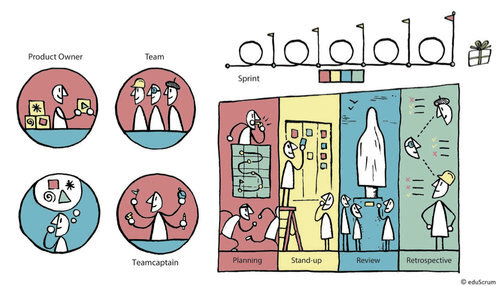As we live in a VUCA world (“Volatile, Uncertain, Complex, and Ambiguous”), working and reacting in an agile manner is a matter of survival for organizations. In this scenario, Agility is here to stay, including in the education industry. Have you ever heard about eduScrum?
Our world is continuously changing at unprecedented speed. Thus, working with a flexible mindset that is open to learning, unlearning, and learning things anew is absolutely vital, as it allows new mental setups to thrive.
We must start fostering such a flexible mindset from the very beginning of our learning process — that is, since childhood.
Given our present scenario, Agility is everywhere. It is a contagious trend that has positively transformed our ways of thinking about our work, as well as about how people and teams interact.
The dissemination of Agility is unstoppable. It has been reaching industry after industry and creating more diverse and horizontal organizations focused on continuous learning.
As expected, this trend also landed in the field of education.
The movement in this direction started 15 years ago when a Dutch teacher, Willy Wijnands, began to apply and adapt one of the Agility frameworks, that is, the iterative and incremental approach of Scrum, to his science classes.
He was gradually able to bring other teachers from all over the world onboard this attempt since many teachers often wonder how to increasingly motivate and engage students of all levels into the educational process.
That is how eduScrum was born. Like Scrum and the whole Agile culture, this initiative has to do with learning and evolution. It could be described as a way of motivating people towards reaching for continuous learning, besides keeping curiosity alive — such a basic trait in children that is often overlooked, or even smothered, in traditional education systems.
But what is eduScrum?

Putting it simply, eduScrum is an active process of highly collaborative education. It is a way of teaching, learning, and evolving that helps students to face complex problems using an approach based on creativity, aiming at bolstering personal development and effectively reaching the learning goals for each subject.
To do that, eduScrum asks students to work in self-organized teams to manage the learning flow and use the Agile mindset since the very first class.
To make this process easier, the students work in teams and learn how to manage the flow of topics to be learned. They are also able to keep track of their progress through visual thinking tools.
In a nutshell, it is safe to say that eduScrum turns the traditional education models upside down.

Based on this perspective, the students form teams that must include diverse and complementary features. Such groups complete prioritized tasks in short “work” cycles and keep track of their progress. In this context, the teacher helps outline such tasks, follows up on the process, and supports the students.
This methodology allows students to own their learning process, thus generating an intrinsic motivation spiral (based on autonomy, purpose, and mastery), in addition to being fun, promoting personal growth, and leading to better academic results.
Education filled with purpose
In this framework, the teacher starts by engaging the students in a learning “game” by explaining WHY one should learn about a given content and WHAT contents will be covered throughout the process. The students, then, are in charge of designing the HOW for each short “work” cycle.

One of the critical ideas of the eduScrum approach is to foster personalized learning by encouraging interaction through the four “C”s of education: creativity, collaboration, communication, and critical thinking.
Like Scrum, eduScrum also establishes the necessary roles for the educational process to take place, as well as events and some artifacts to optimize the workflow. This means that the student teams will have a facilitator, that is, the eduScrum Master, who will help maintain the method’s integrity and promote the Agile culture routinely, as well as to identify and remove impediments.
The teacher will energize the role of a Product Owner who determines the different academic topics that must be approached in each cycle, or Sprint, and prioritize each topic according to its value to the learning process.
Each student team has its own learning Backlog, which is also prioritized. Tasks move through a board, where it is possible to visualize the advances in learned content. Once each Sprint starts, the team plans the work that they will be carrying out during the cycle and estimates the effort needed for each task (Planning Meeting).
Daily, during each class, the students come together to briefly discuss the advances, to share what they already completed, on what they will learn, and if they have any impediments or need any help (Daily Meeting)
Once each Sprint is completed, the teams put aside some time to present the advances and collect feedback from the PO (which is equivalent to Scrum’s Sprint Review Meeting).
Finally, before embarking on a new work cycle, the team holds a Retrospective Meeting. The participants evaluate how to improve their interactions and deliveries by identifying points for improvement in the way that they worked.
Pedagogical foundations of eduScrum

The eduScrum approach was designed to promote a more efficient learning process, to foster teamwork and knowledge sharing.
To achieve such purposes, this educational framework holds a peculiar ceremony where the “working” teams are formed using a collaborative format and based on the skills of the team members.
As we often say about Scrum itself, eduScrum is easily understandable, but implementing it is far from easy. How to get started? By experimenting with it!
Would you like to know more about Scrum?
Learn more about the Certified ScrumMaster (CSM) training program. Come learn the Scrum methodology pillars and how to deal with the main challenges for successfully using Scrum in your projects!
